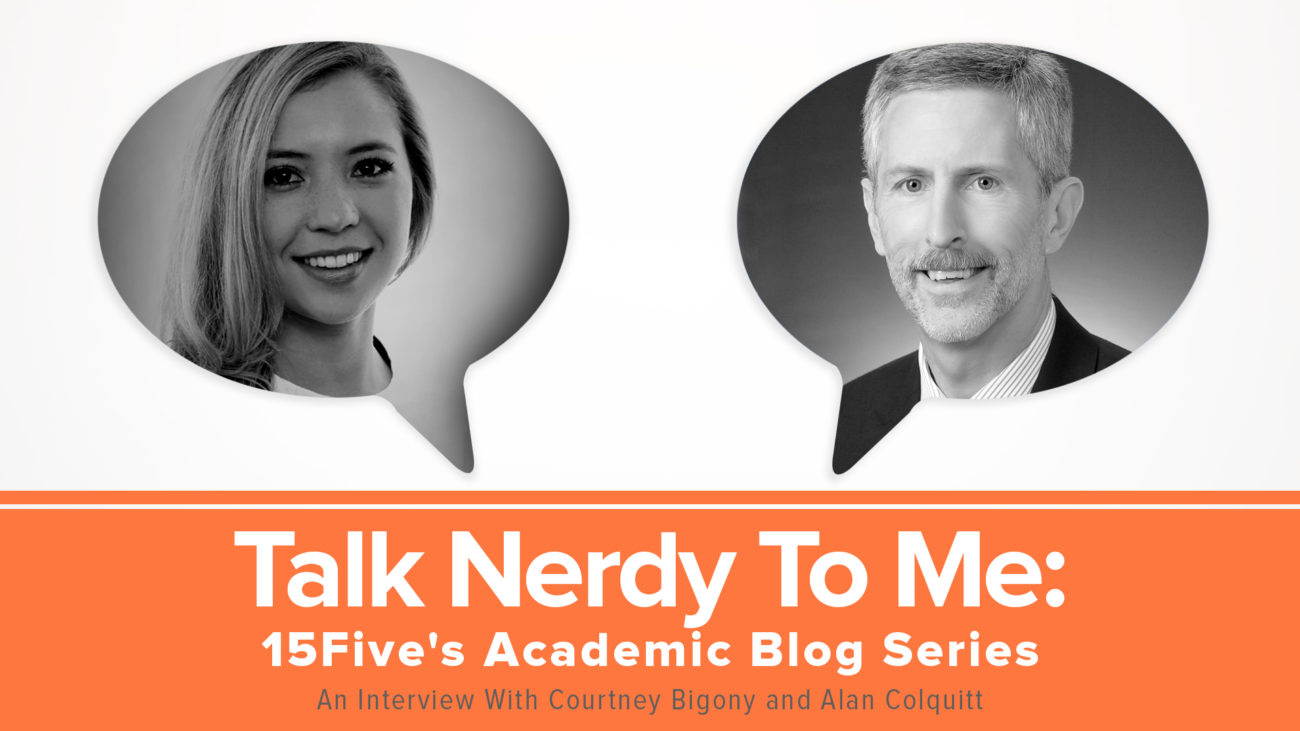Progressive Performance Management: Why Your Employee Compensation Strategy Is Holding You Back
Welcome to Talk Nerdy To Me, 15Five’s academic blog series where we get nerdy, talk to the world’s best thinkers, and break down the latest academic research that you can apply to your workplace.
The Annual Performance Review is Dead! Or is it? One of the main issues that HR leaders face when considering a progressive performance management program is how to revamp their employee compensation strategy. Is it possible to ditch ratings and stack rankings and still determine whether people are ready for advancement or increased pay? Not only is this possible, there are strategies that are even more effective…
Alan Colquitt is one of the world’s greatest experts in the field of HR and performance management. He is the author of the recently published book Next Generation Performance Management: The Triumph of Science over Myth and Superstition and has spent over 30 years helping organizations implement scientifically sound and effective people and organizational practices, including 5 years at Procter & Gamble and 27 years at Eli Lilly and Company.
Alan has been named one of the 100 top HR influencers of 2017 by Engagedly. He received his bachelor’s degree in Psychology from Indiana University and his masters and Ph.D. in Industrial and Organizational Psychology from Wayne State University.
This conversation has been edited and condensed. To listen to the full conversation, click the video below.
Courtney: In your book, Next Generation Performance Management, you differentiate between Performance Management 1.0 (PM 1.0) and Performance Management 2.0 (PM 2.0). Can you explain the difference between the two?
Alan: PM 1.0 is shorthand for last generation (traditional) performance management, which I would say most companies are doing now. It is designed mainly for administrative reasons, and involves setting goals at the beginning of the year, evaluating performance, and distributing rewards at the end of the year. The center of the universe for PM 1.0 is evaluation, ratings, and differentiation.
In contrast, PM 2.0 focuses on providing continuous direction, alignment, meaning, and purpose to employees. The center of the universe here is goals and when I refer to goals, I’m talking about the context within which people work. It’s focused on making progress towards goals and connecting work to a larger purpose.
In PM 1.0, individuals are the unit of analysis. They set goals, receive employee feedback and performance evaluations, and these individuals then receive distributed rewards. In the future, this isn’t going to work and teams will be the central unit of analysis. Teams will be the way we get things done, so teams need to be the way we manage work and manage performance. Those are the big differences.
Courtney: What was your main motivation for writing this book?
Alan: In the mid-90s, forced distribution performance systems were all the rage. When I was given responsibility for revamping performance management at my company, I thought, there’s got to be a better way to do this, so I turned to science. I was surprised to learn it wasn’t very supportive of what we do. I wondered, if we’re not listening to the science, what are we listening to?
I was interested in the whole system that holds traditional performance management practices in place despite the fact that they don’t work very well, despite the fact that we dread them, and despite the human suffering that occurs every year in organizations. Performance management was something to be endured in organizations, it wasn’t something that you leveraged. Instead of using performance management to evaluate your people, a better position is to use it to implement your strategy.
Courtney: What we’re really talking about is evidence-based management—looking at the best available evidence instead of looking at best practices to design people programs.
Alan: A lot of the good evidence isn’t just in psychology or management literature—a lot of the evidence is in economics and other disciplines as well. That was a big surprise for me.
Courtney: And that’s what makes your book so unique—you look beyond psychology research and also look at economic theory. You also look beyond practices and instead, look at paradigms.
Alan: Organizations are famous for what Chris Argyris calls “single-loop” learning. Single-loop learning occurs when we try something and it fails and then we try something different. If we’re really going to learn, we need to engage in double-loop learning, so when something doesn’t work, we step back and take into account the values, assumptions, and beliefs surrounding the problem and our solutions.
For example, with performance ratings, it’s not about going from three rating categories to five. That’s iterating in the margins of old paradigms. Instead of asking how many rating categories we should use, we need to ask if we can accurately evaluate employee performance via ratings well enough to tie big rewards to it.
Faulty assumptions and beliefs are behind Performance Management 1.0—that people can evaluate performance accurately and that money and contingent rewards motivate others.
In Next Generation Performance Management, Alan notes that PM 1.0 is driven by classical economic theory:
“that people are self-interested, motivated by money, interested in maximizing gains and minimizing losses, rational, and efficient. These beliefs lead organizations to emphasize employee compensation and reward systems to motivate people… Agency theory also assumes that employees are self-interested and that the goals of the employee will not be aligned with the goals of the organization. As a result, other mechanisms (rewards, incentives, monitoring, fear of being fired) are needed”.
This is the paradigm driving the unbreakable chain between performance management and rewards in PM 1.0.
Courtney: The issue of ratings is one of the biggest debates in the HR world. What’s the classical economic theory driving performance ratings?
Alan: PM 1.0 assumes that ratings will motivate people to work hard and increase performance. But the science supporting this is weak. There’s a great study by Wharton economist, Iwan Barankay. In his research, the people who were rated, especially when rated relative to others, were less likely to return to work and were less productive if they did.
I think that’s one of the problematic assumptions for us—people want to know how they’re doing but that doesn’t mean they want to be rated. And there’s lots and lots of research showing that human beings are terrible raters, evaluators, and observers.
In Next Generation Performance Management, Alan points to research showing how biased humans really are and that these biases infect the accuracy of performance ratings. PM 1.0 assumes that ratings can be made accurately, yet research shows that people cannot rate performance accurately, consistently, or fairly.
Courtney: In your book, you advise against pay for performance. You warn people that when companies say they “pay for performance”, in reality, they “pay for performance ratings”. But ratings are biased and inaccurate. They don’t tell us much about actual performance. So, if companies distribute compensation based on ratings like most are, they have errors in their performance measures.
Because ratings are so biased, many companies are ditching ratings. But they still don’t abandon pay for performance. Why is that?
Alan: In PM 1.0, ratings are tied to rewards and traditional rewards generally include pay for performance (ratings) and bonuses. A lot of what ratings do for HR is risk mitigation so they don’t overspend on the budget. That’s why we put in place calibration and forced distribution systems—so we know what percentage of people are going to get the top rating and how much money is associated with that so we can budget.
The big problem I have with this is that we’re talking about employee motivation here, but it’s really a cost game. We’re looking at highly efficient ways to distribute motivational dollars, but is it effective? We’re flawed in the way we tie motivation and rewards together.
I think the prospect of getting rid of them is very daunting. There’s been lots of murmurings and discussions about getting rid of performance ratings but very few companies have actually done it. The reality is, it’s very easy to manage pay without ratings and there are a couple ways to do it.
In Next Generation Performance Management, Alan notes that we can:
1. Focus more on base pay (and less on bonuses)
2. Use market-based adjustments (pay people at or above market rate)
3. Use team and organizational based incentives (or other outcomes like profit sharing, gainsharing, employee ownership, or stock ownership)
He elaborates below:
Alan: On the rewards side, there are lots of ways to manage and increase employee compensation without traditional pay for performance programs. The big one is to move from an individual level framework to a team or organizational level framework like profit sharing, gainsharing, and stock ownership programs. And the great thing about these programs is that they work!
There’s lots of research showing that companies who implement profit and gainsharing programs experience significant productivity and performance improvements. And you get all that without the crazy side effects of individual pay for performance programs like distortion, manipulation or worst case scenario, fraud. Pay for performance plans can also create cultures of competition and demotivate.
The other thing I would do is move away from broad banding and go back to narrow banding so you can promote people more often. In broad banded job structures, there are only a few levels (opportunities for promotion), but lots of room in terms of salary increase. With only a few levels, people get promoted less frequently, which is really demotivating.
Smart companies will use narrow banding instead. With narrow banding, there are lots of levels, meaning lots of opportunities for promotion. Psychologically there’s nothing like a robust internal labor market to increase employee motivation.
Courtney: In your book you say, and I love this line, “Use jobs to motivate. If you have only one motivational bullet—look at the work people do.” That’s a pretty powerful statement. Can you unpack it a bit?
Alan: Is my work interesting? Is it challenging? Does it leverage my strengths? Does it serve a larger purpose? If you measure those factors on surveys, you’ll find those are your top drivers of employee engagement, satisfaction, and retention.
And in the research I did, I found that engaging people with interesting and challenging work, more responsibility, and more autonomy is about 2.5x more powerful than money in retaining people.
We teamed up with Alan Colquitt, author of Next Generation Performance Management, to show the keys to progressive performance management and why your rating and compensation strategy is holding you back. Check out the video below to learn more.

Courtney Bigony is Director of People Science at 15Five, continuous performance management software that includes weekly check-ins, objectives (OKR) tracking, peer recognition, 1-on-1s, and reviews. She is also the founder of The Deep Feedback Movement, where she provides actionable insights for People Teams based on the latest social science research, and a Fellow at the Center for Evidence Based Management.




